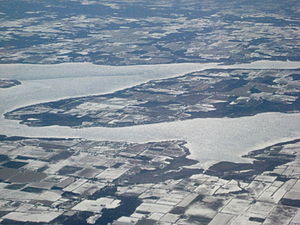Lake Scugog
| Lake Scugog | |||||||||
|---|---|---|---|---|---|---|---|---|---|
| Lake Scugog in winter | |||||||||
|
|||||||||
|
|
|||||||||
| Coordinates | 44 ° 11 '0 " N , 78 ° 51' 26" W | ||||||||
| Data on the structure | |||||||||
| Data on the reservoir | |||||||||
| Altitude (at congestion destination ) | 249.9 m | ||||||||
| Water surface | 68 km² | ||||||||
| Storage space | 95 700 000 m³ | ||||||||
| Catchment area | 529 km² | ||||||||
Lake Scugog is an artificial lake in Scugog Township in the Canadian province of Ontario .
It lies between the two cities of Port Perry and Lindsay . The water level of the lake has been raised and lowered several times in the past. Lake Scugog has a total area of 63.74 km² and a maximum depth of 7 m.
etymology
The name "Scugog" is possibly an Ojibwe word for "boggy water". According to Alan Rayburn's Place Names of Ontario , "Scugog" is a Mississauga word that means "waves lapping in a canoe".
geography
Lake Scugog has an area of 68 km² and an average depth of 1.4 m. Notable tributaries are: Blackstock Creek, Cawkers Creek, and Nonquon River.
Its only outflow is the Scugog River , which flows north to Sturgeon Lake , one of the Kawartha Lakes .
Lake communities include: Seagrave , Port Hoover, View Lake, and Ceasarea. Scugog Island , the island status of which is controversial as its southwestern part is a seasonally flooded marshland, is centrally located in the lake.
A 2.58 km ² Indian reservation of the Mississaugas with a population of 50 is located on Scugog Island.
Hydrology
About 1 mm of marl is deposited in the lake every year. During dry periods in summer, the lake loses a lot of water through evaporation. The water level then drops so much that the outflow over the Scugog River comes to a standstill.
history
The lake has a history of changing water levels. Originally there were two lakes, which were connected by a wide canal. The canal ran through swampy terrain. In 1834 a dam was built at Lindsay on the Scugog River to power a flour mill with water power. The water level rose by over 3 meters and flooded the original lakes. Today's dam is further upstream.
During this period in the 1830s, when the water levels were high, the islands of Washburn, Nonquon (now Seven Mile), Ball, Platten and the great centrally located Scugog formed. Today these form part of the mainland with the exception of Scugog Island. Due to man-made canals, Scugog Island is still considered an island today.
The stagnant water was the cause of epidemics on the nearby farms. The local population did not accept the reservoir and finally tore down the dam in the summer of 1838.
The water level of the reservoir was then lowered by one meter in 1843. This corresponded to the maximum natural water level during the spring floods.
The Board of Works of the Province of Canada took on the construction of a new dam and lock, which were completed in 1844. He also owned a wooden giant for tree trunks.
Natural history
The marshland surrounding the original lakes used to be rich in water rice and cranberries , which were harvested by the indigenous people. The flooding of these areas led to their disappearance.
The lake is rich in fish. There is an ice fishing season from January 1st to March 1st. The following types of fish are caught in Lake Scugog: eyeglasses , largemouth bass , black bass , muscle lung , American perch , crappie and sunfish .

